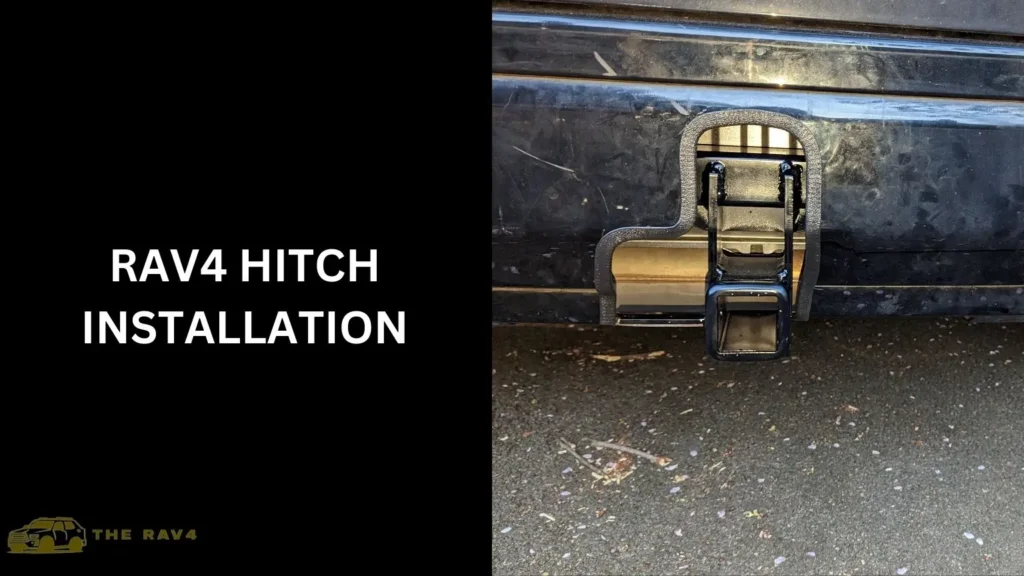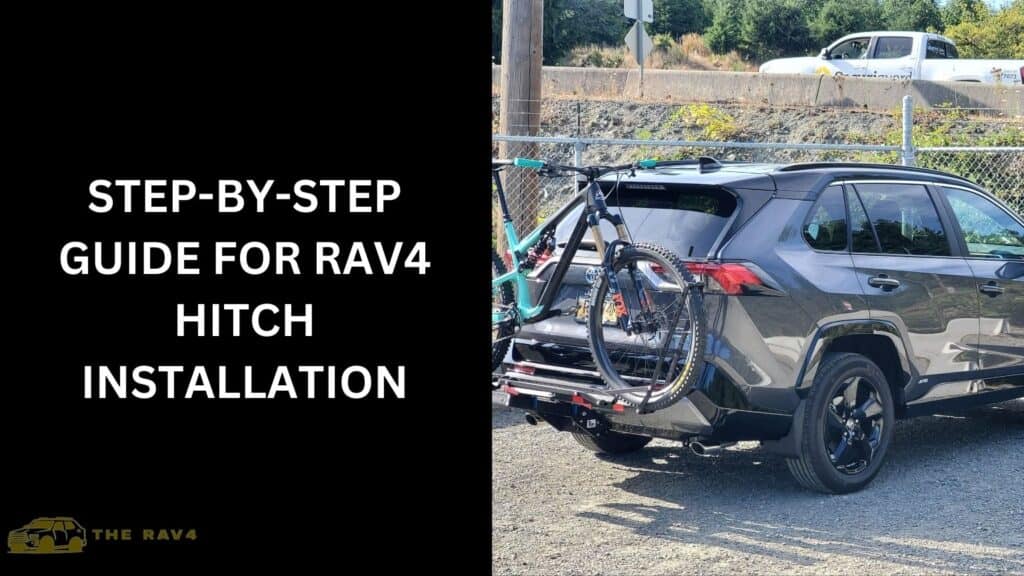When it comes to maximizing the utility of your Toyota Rav4, installing a hitch can significantly enhance its capabilities.
Whether you’re an outdoor enthusiast, a camper, or simply need to tow trailers or carriers, a hitch opens up a world of possibilities for your Rav4.
RAV4 Hitch Installation, In this guide, we’ll walk you through the process of hitch installation, ensuring you have the right tools, knowledge, and steps to do it correctly.

Introduction to Rav4 Hitch Installation
The installation of a hitch on a Toyota Rav4 is a significant enhancement that adds versatility and utility to the vehicle.
It allows Rav4 owners to tow trailers, bikes, or cargo carriers, expanding the range of activities and adventures they can pursue.
We will delve into the details of Toyota hitch installation, covering the types of hitches available, tools needed, step-by-step installation instructions, common mistakes to avoid, and the benefits of professional installation versus DIY.
Whether you’re a DIY enthusiast or prefer professional assistance, understanding the process of Toyota hitch installation can help you make informed decisions to optimize your vehicle’s capabilities.
What is a Hitch?
A hitch is a mechanical component installed on a vehicle’s rear that enables towing capabilities. It serves as a connection point for attaching trailers, bike racks, or cargo carriers.
Importance of a Hitch for Rav4 Owners
For Rav4 owners, a hitch opens up a world of possibilities. Whether it’s hauling camping gear for outdoor adventures or transporting bicycles for a weekend getaway, having a hitch significantly expands the vehicle’s functionality.
Brief Overview of the Installation Process
Installing a hitch on your Rav4 may seem daunting at first, but with the right tools and knowledge, it can be a straightforward process.
The key is to understand the type of hitch that suits your needs and follow proper installation procedures.
Types of Hitches for Rav4
There are several types of hitches available for the Toyota Rav4, categorized based on their towing capacity and compatibility:
- Class I Hitch: Ideal for light-duty towing, such as bike racks or small trailers.
- Class II Hitch: Offers higher towing capacity for medium-sized trailers or campers.
- Class III Hitch: Suitable for towing larger trailers, boats, or utility vehicles.
- Class IV Hitch: Provides heavy-duty towing capability for larger loads.
Tools Required for Rav4 Hitch Installation
Before diving into the installation process, gather the following tools:
- Socket wrench set
- Torque wrench
- Screwdrivers (Phillips and flathead)
- Pliers
- Safety goggles
- Level
- Hitch receiver kit (including bolts and brackets)
Preparation Steps Before Installation
Safety should always be a priority when installing a hitch. Begin by:
- Reading the vehicle’s manual for specific instructions.
- Ensuring the vehicle is on a level surface.
- Disconnecting the battery to avoid electrical mishaps.
Step-by-Step Guide for Rav4 Hitch Installation

Here’s a step-by-step guide for installing a hitch on a Toyota Rav4:
Gather Necessary Tools
Before starting, gather the required tools including a socket wrench set, torque wrench, screwdrivers (Phillips and flathead), pliers, safety goggles, level, and the hitch receiver kit with bolts and brackets.
Prepare the Vehicle
Park the Rav4 on a level surface and engage the parking brake. For added safety, disconnect the negative terminal of the battery.
Remove Bumper
Use a socket wrench to remove the bumper fasteners. Carefully detach the bumper from the vehicle and set it aside.
Position Hitch Receiver
Position the hitch receiver beneath the vehicle’s frame. Ensure it aligns correctly with the mounting points.
Attach Hitch Receiver
Secure the hitch receiver in place using the provided bolts and brackets from the hitch kit. Hand-tighten the bolts initially.
Use Torque Wrench
Use a torque wrench to tighten the bolts to the manufacturer’s recommended torque specifications. This ensures a secure and safe attachment.
Check Alignment
Double-check the alignment of the hitch receiver. Make any necessary adjustments to ensure it is straight and level.
Secure Connections
Ensure all connections are tight and secure. Double-check bolts, brackets, and any additional hardware for proper installation.
Reattach Bumper
Carefully reattach the bumper to the vehicle, aligning it with the mounting points. Tighten the bumper fasteners securely using a socket wrench.
Test the Hitch
Connect a trailer or hitch accessory to the hitch receiver. Apply gentle pressure to ensure a secure connection. Test the lights and brakes to confirm functionality.
Final Checks
Conduct a final visual inspection of the hitch installation. Check for any loose bolts or components. Ensure there are no obstructions or issues with the hitch.
Complete Installation
Once everything is secure and tested, reattach the negative terminal of the battery if disconnected. Clean up any tools or debris from the installation area.
Common Mistakes to Avoid
Avoiding common mistakes during the Rav4 hitch installation process is crucial to ensure safety, functionality, and longevity. Here are some common mistakes to avoid:
Neglecting Vehicle Compatibility
Ensure that the hitch you choose is compatible with your specific Rav4 model and year. Different models may have varying towing capacities and mounting points.
Improper Tightening of Bolts
Failing to tighten bolts and nuts properly can lead to instability and potentially dangerous situations while towing. Use a torque wrench to tighten bolts to the manufacturer’s recommended specifications.
Skipping Safety Checks
Always perform safety checks after installation. Test the hitch with a load to ensure it can handle the weight without issues. Check lights, brakes, and connections for proper functionality.
Ignoring Wiring and Electrical Connections
If your hitch installation requires wiring for trailer lights or brakes, ensure that all electrical connections are secure and properly insulated. Faulty wiring can lead to electrical issues or accidents.
Overlooking Rust Prevention
Apply rust-resistant coatings or lubricants to exposed metal parts of the hitch to prevent corrosion and extend its lifespan, especially if you live in a corrosive environment or use the hitch frequently.
Not Following Manufacturer Instructions
Always refer to the manufacturer’s instructions and guidelines for installing the specific hitch model on your Rav4. Deviating from these instructions can lead to installation errors and safety hazards.
Incorrect Load Distribution
When towing, ensure that the weight is evenly distributed and within the hitch’s specified weight capacity. Improper load distribution can affect vehicle handling and stability.
Skipping Regular Maintenance
After installation, regularly inspect the hitch for signs of wear, loose components, or rust. Lubricate moving parts as needed and address any maintenance issues promptly to avoid safety risks.
Benefits of Professional Installation vs. DIY
While hiring a professional ensures expert-level installation, DIY enthusiasts can benefit from:
Professional Installation:
- Expertise and Experience: Professional installers have the knowledge and experience to install hitches correctly the first time. They are familiar with various Rav4 models and can handle complex installations efficiently.
- Quality Assurance: Professionals use high-quality tools and equipment, ensuring that the hitch is installed securely and according to manufacturer specifications. This reduces the risk of installation errors or safety hazards.
- Time-Saving: Professional installation is often quicker than DIY, as installers are skilled in the process and can complete the job efficiently. This is beneficial for those with busy schedules or limited experience in automotive work.
- Warranty Coverage: Many professional installations come with warranty coverage for the hitch and installation work. This provides peace of mind and protection against any issues that may arise post-installation.
- Safety and Compliance: Professionals ensure that the hitch installation meets safety standards and legal requirements. They understand weight capacities, and towing regulations, and ensure proper wiring and connections for trailer lights and brakes.
DIY Installation:
- Cost Savings: DIY installation can save money on labor costs associated with professional installation. This is ideal for budget-conscious individuals who are comfortable working on their vehicles.
- Personal Satisfaction: Completing a DIY project can be rewarding and provide a sense of accomplishment. It allows enthusiasts to learn about their vehicle’s mechanics and gain hands-on experience.
- Flexibility and Convenience: DIY installation gives you the flexibility to choose the timing and location of the installation. You can work at your own pace and customize the installation to your preferences.
- Learning Opportunity: DIY installations offer a learning opportunity to understand how hitches are installed and how they function. This knowledge can be valuable for future maintenance and repairs.
- Customization Options: DIY installers can choose specific hitch models and accessories based on their needs and preferences, providing customization options that may not be available with professional installations.
Maintenance Tips for Rav4 Hitch
To prolong the lifespan of your Rav4 hitch, follow these maintenance guidelines:
- Conduct regular inspections for signs of wear or damage.
- Lubricate moving parts to prevent rust and corrosion.
- Clean the hitch after use, especially in harsh weather conditions.
Safety Considerations
Always adhere to safety guidelines when towing with your Rav4 hitch:
- Respect the weight capacity and towing limits specified for your hitch.
- Properly distribute weight to maintain vehicle stability.
- Use caution when towing on steep inclines or rough terrain.
Cost Analysis
The cost of a Rav4 hitch varies based on the type and brand. On average, expect to invest between $200 to $500 for the hitch itself. Additional costs may include professional installation fees, ranging from $100 to $300 depending on complexity.
Customer Reviews and Recommendations
Rav4 owners who have installed hitches often share valuable insights:
- “The Class III hitch transformed my Rav4 into a versatile towing machine.”
- “DIY installation was straightforward, thanks to detailed instructions.”
Environmental Impact of Hitch Installation
Efficient towing practices can contribute to fuel savings and reduced emissions:
- Properly loaded trailers improve fuel efficiency.
- Eco-friendly towing techniques minimize environmental impact.
Future Trends in Rav4 Hitch Technology
As technology evolves, expect advancements in hitch design and integration:
- Enhanced hitch features, such as integrated sensors for trailer monitoring.
- Seamless connectivity with vehicle electronics for towing assistance.
Legal Requirements and Regulations
Before hitting the road with your Rav4 hitch, ensure compliance with local laws:
- Obtain necessary licenses or permits for towing.
- Register your trailer or vehicle modifications as required.
People also ask
How much does it cost to install a hitch on a RAV4?
The cost of installing a hitch on a RAV4 typically ranges from $100 to $300 for professional installation,
while a DIY installation can save on labor costs but may still require purchasing the hitch kit, which can range from $200 to $500 depending on the type and brand of the hitch.
Can you add a hitch to a RAV4?
Yes, a hitch can be added to a RAV4. It’s a common aftermarket accessory that enhances the vehicle’s towing capabilities, allowing it to tow trailers, bikes, or other equipment.
Does the Toyota RAV4 have a tow package?
Some Toyota RAV4 models come with a factory-installed tow package, which includes features like a hitch receiver,
wiring harness for trailer lights, and possibly a transmission cooler for towing heavier loads.
However, not all RAV4 trim levels or configurations include a tow package, so it’s important to check the specific model and options when purchasing.
Is it worth it to install a trailer hitch?
Installing a trailer hitch on a vehicle like the RAV4 can be worth it if you need to tow trailers, bikes, or other equipment regularly.
It enhances the vehicle’s versatility and utility, making it suitable for various recreational and practical purposes.
Conclusion
Installing a hitch on your Toyota Rav4 not only expands its functionality but also enhances your overall driving experience.
By following proper installation procedures, conducting regular maintenance, and prioritizing safety, you can enjoy seamless towing capabilities for various recreational and utility purposes.